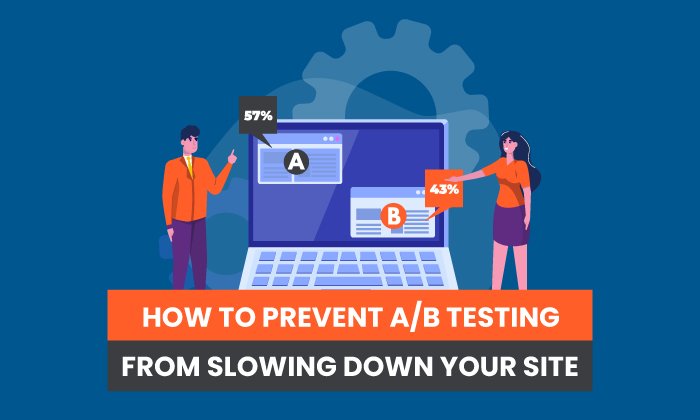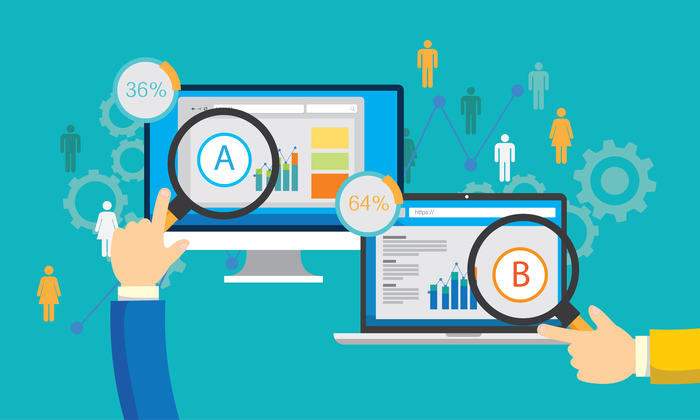MARKETING
7 Neuroscience Sales Tips That’ll Skyrocket Your Sales

Selling can be challenging because it involves s a complex process of human behavior and cognition.
More than likely, marketers who struggle to win customers either haven’t been prospecting the right way or aren’t putting in enough effort.
In this in-depth article, you’ll learn how to leverage the power of the human brain with neuroscience sales tips.
Whether you’re selling a digital product online or you run a brick-and-mortar business, these behavioral neuroscience principles will work for you. They’ll help you drive more visitors into your marketing funnel and convert casual visits into sales.

1. Influence Drives the Value of Your Product
Influence marketing is here to stay, so you should embrace it.
Influence is your ability to persuade others to adopt your own perspective. You believe in your product (e.g., online course, ebook, software), so you naturally want others to believe in it, too.
Your ability to persuade others in this way by appealing to their emotions will increase your sales. Influence increases the perceived value of your products.
You see, influential people tend to sell more product. It’s not because they’ve created the best product — sometimes, that’s just not true — but because over the years, they’ve built credibility. People trust their opinions.
For example, in the digital marketing world, people trust Seth Godin. That’s because Seth Godin has written over 20 bestselling books. He’s a sought-after public speaker and social media influencer.
Seth doesn’t waste words. Most of his posts have fewer than 200 words, like the one below, but the social sharing and engagement for these posts is amazing.
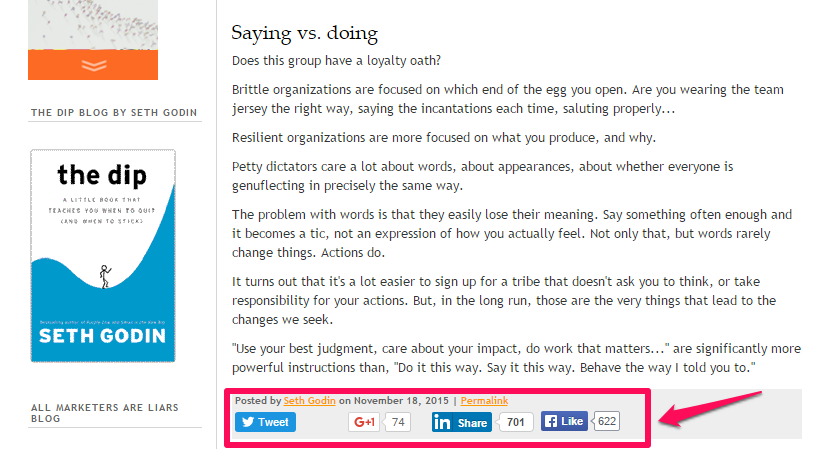
Remember that influence isn’t the same as popularity. They’re not interchangeable, though a lot of people regard them as such.
Brian Solis reports that one person responding to a survey he conducted with Vocus put it like this:
Popularity is just that people like you, influence is when they listen to you.
When you’re selling online, becoming popular shouldn’t be your ultimate focus. Spend time building your influence. It takes time, but it’s worth the effort.
In the book Influence: The Psychology of Persuasion, author Robert B. Cialdini, Ph.D., identifies the 6 factors that get people’s brain function to do something that they wouldn’t have ordinarily done.

In my experience as a content marketer who’s built a loyal audience, influence can be achieved through consistently creating useful content for your target audience and forming relationships with influencers and readers.
If you’re a blogger, you’ve already cleared the first hurdle of building authority and influencing people. Macallan persuaded 32 people to do marketing for the company. This resulted in a huge increase in exposure and influence over an audience of 150,000 people.

Next, give adequate time to content creation and building friendships. Reply to comments, answer questions, and, every so often, visit a reader’s blog and give them some free feedback or tips on how to improve their site.
Public speaking is another way to establish your personal brand and build a loyal following.
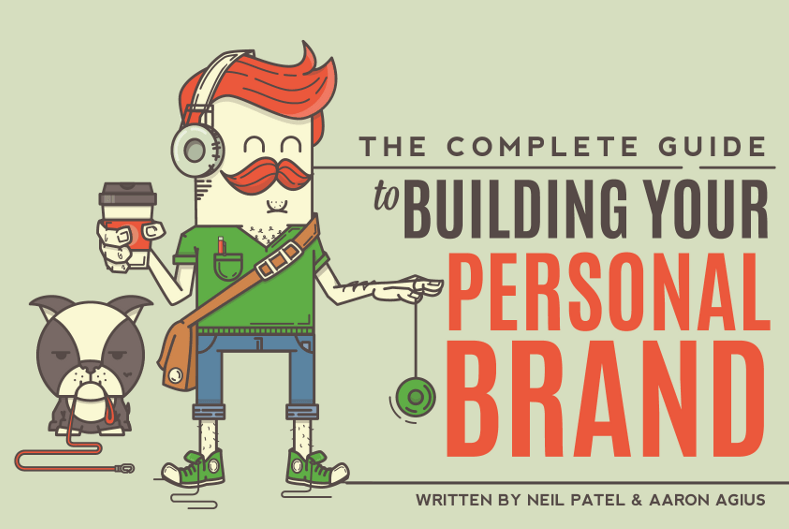
2. You Have to Sell Yourself Before You Can Sell Your Product
Make no mistake: You’re a product; and like any product, you have to successfully communicate the value of that product. Until that happens, you’ll find it difficult to sell your actual products or services.
Before anybody is going to buy from you or your company, they’ve got to ‘buy’ the idea that you’re somebody worth working with. In other words, just like a job candidate, your first task is always selling yourself.
Email marketing is the most effective lead generation tactic, followed by websites/landing pages and then content marketing. But guess what? Each of these tactics will work better when you first sell yourself, then the product.

Selling yourself isn’t an insurmountable challenge. There are lots of opportunities in today’s world of marketing to appeal to the human brain. However, with many opportunities come an increase in competition.
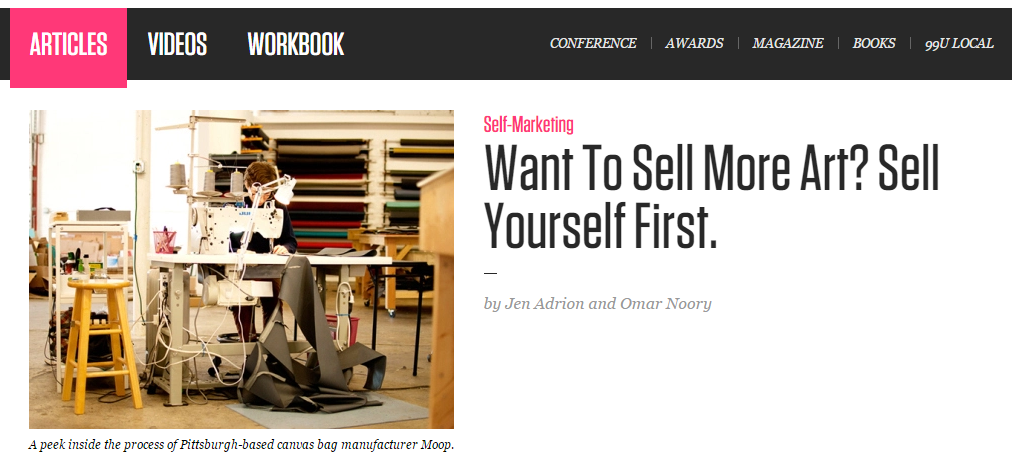
In a sea of writers, bloggers, freelancers, consultants, public speakers, etc., how do you stand out from the crowd?
It’s simple: Become passionate about your product.
When you’re selling yourself, you’re not concerned about the money. Your responsibility is to educate others’ human minds as you convey your brand’s core message.
HelpScout doesn’t just try to sell help-desk software. Instead, it also sells itself as a brand.
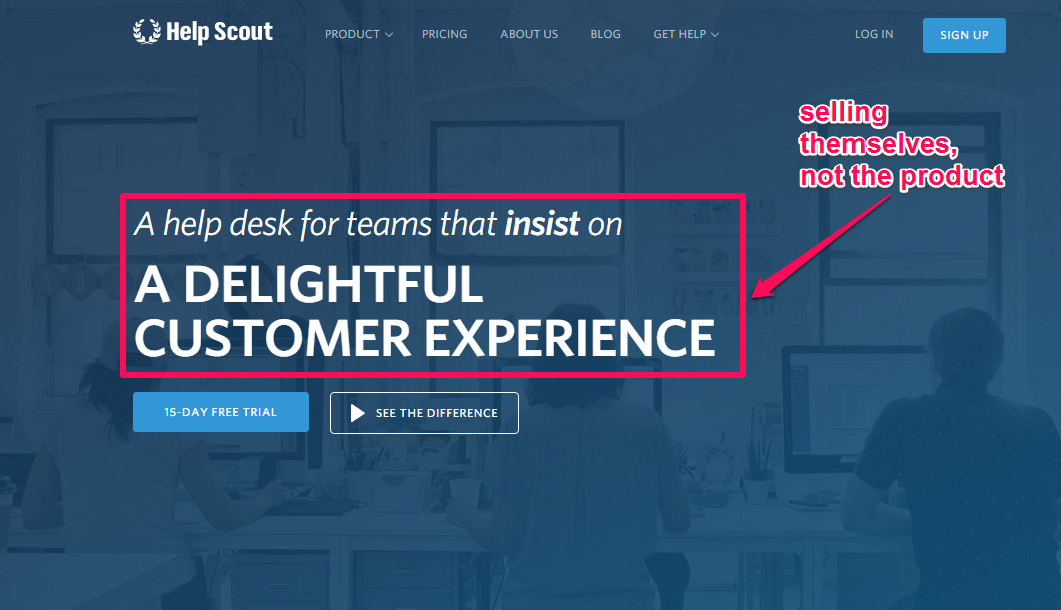
Learning how to sell yourself first is critical to your success. No matter what product you’re offering for sale, do your best to connect with and communicate your core brand values to your prospects.

3. Build Interest with Features; Build Desire with Benefits
Sell the benefits, not the features.
Most people and companies think products and services sell because of their great features. That’s not the case.
Harvard Business School conducted a research study and found that products of all kinds sell because of their benefits. The benefits that drive sales aren’t always obvious from the customer’s perspective though.
Whether you’re selling via email, direct mail, or social selling, highlight the benefits as well as the features of your product.
Starting with the strongest benefits of your product will reassure customers that you care about them, not (just) their hard-earned money, providing social security.
Selling with benefits means that you’re transparent with your customers. That’s exactly what their cognitive function wants.
Copywriters know how to sell benefits.
For example, Dan Kennedy wrote sales copy that generated over $10 million in sales over the years. It’s the same with Eben Pagan, Frank Kern and several top digital entrepreneurs.
These people were successful because they focused on benefits, not features. Successful selling boils down to one thing: showing your customers how your offer/product meets their needs.
Kat Night agrees that quantifying the benefits of a product is more likely to result in a sale than describing its features.
However, in order to avoid misleading prospects and customers, you have to start by building interest with features. Then, you increase their desire for your product with benefits.
When people are searching for a solution to meet their needs, what their brain function is actually looking for is a future that appeals to them. According to BufferApp, “people don’t buy products, they buy better versions of themselves.”
Consumers are happy to spend money on products that’ll make their lives better. Before the iPod was invented, there were MP3 players on the market. So iPod sold the benefit: “1,000 songs in your pocket.”
What’s the difference between a benefit and a feature?
This is how the folks at User Onboard explain:

In a nutshell, benefits are what you (or your prospects) can do with a product. Features are what the product can do. They sound similar, right? Yet, they’re totally different things.
“You can get fit without straining your joints with an elliptical trainer” targets the benefit. “Easy-glide motion, timer, and adjustable intensity settings” are all features.
See the difference?
Customers’ cognitive functions are different depending on where they are in the buying journey. Their human brains all must first recognize a need, then seek potential solutions, evaluate the solutions, decide to take action, and finally make the purchase.

Use features at stages 1 and 2; benefits will work better on their brain activity when they’re actually making purchase decisions (stages 4 and 5).
Professor Albert Wenben from the University of Wisconsin-Madison conducted a study on the topic of “Consumer Values, Product Benefits and Customer Value: A Consumption Behavior Approach.”
He found that “from the customers’ perspectives, products are viewed as a bundle of benefits, not attributes” (features).
MBA Skool suggests that a product benefit is usually the answer to customer’s questions. You probably already know that questions are driven by the psychological phenomenon of an emotional desire to know more.
The level of satisfaction derived from a product will differ depending on human behavior and cognitive neuroscience. After all, two people may both need a product, but one can need it desperately, while the other could get along without it.
To get the best results, highlight 70% of your product’s benefits, and 30% of the features.

Let’s look at an example in the world of marketing consulting services and products.
For most retailers with optimized and high-functioning websites, SEO and email marketing are more beneficial than a Facebook page. That’s not always true for other retailers.
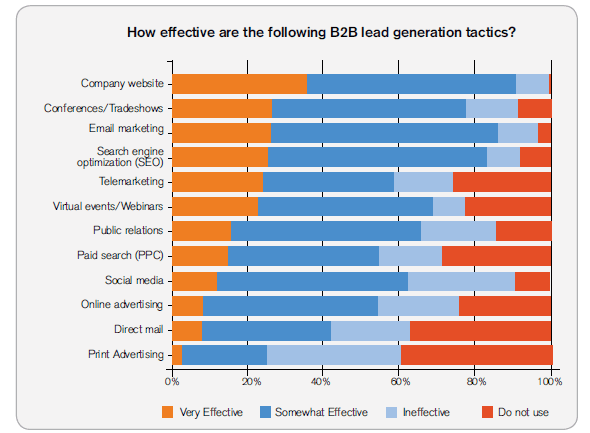
If you help businesses set up a Facebook marketing campaign (including a fan page), you need to sell with benefits while targeting your ideal customers (e.g., those without a functional website or with low-performing sites).
People buy products emotionally, and justify the purchases logically. When you use brain science to build interest with features and create strong desire with benefits, you’re meeting your prospects where they are and giving them the social security and social proof they need to feel confident in the purchase.
When you evoke the appropriate emotions, customers may not even know why they’re responding to your product. But they’ll buy it.
Remember that benefits are the things that you can do with a product, while features are what the product can do. Let’s look at a few real-world examples:
Twitter is a unique micro-blogging platform. It helps you update your timeline in real-time. It all began from their value proposition, based on the platform’s benefits: “start a conversation, explore your interests and be in the know.”
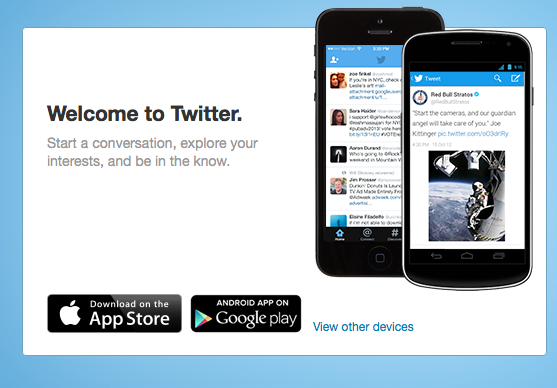
Volusion.com has a unique value proposition that simply and strongly projects the core benefit of its software.
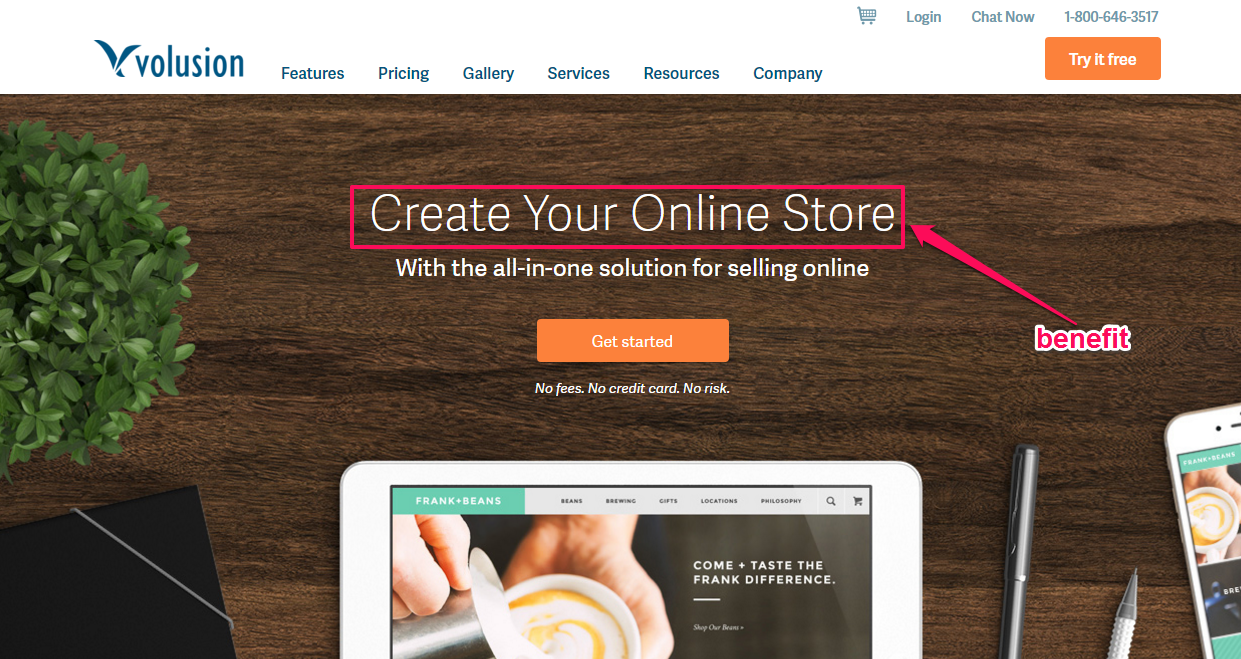
It’s your responsibility to study your product and know its features, benefits and advantage over your competitor’s product.
4. Sell the Results by Painting a Clear Picture
Are you selling your product’s results?
If you don’t do that consistently, you’ll likely struggle to acquire qualified leads and increase conversion and revenue.
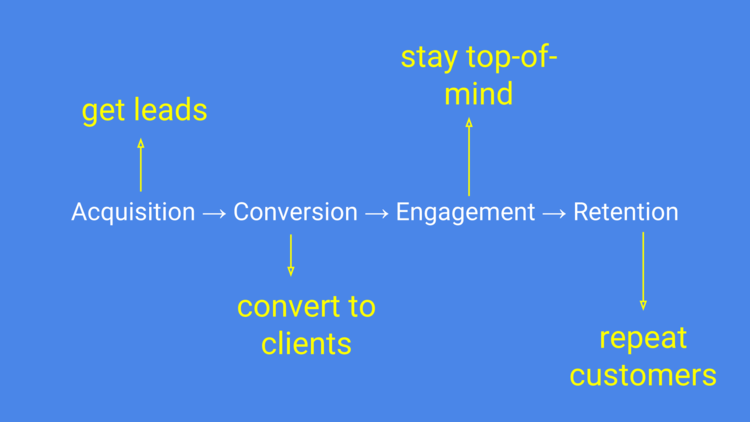
These days, most of us are selling to a new generation of customers: the millennials.
Millennials are a unique set of people born between 1982 and 2000 and making up 26% of the world’s population. Over 23% of millennials hold a bachelor’s degree or higher, making them the most educated generation in history.
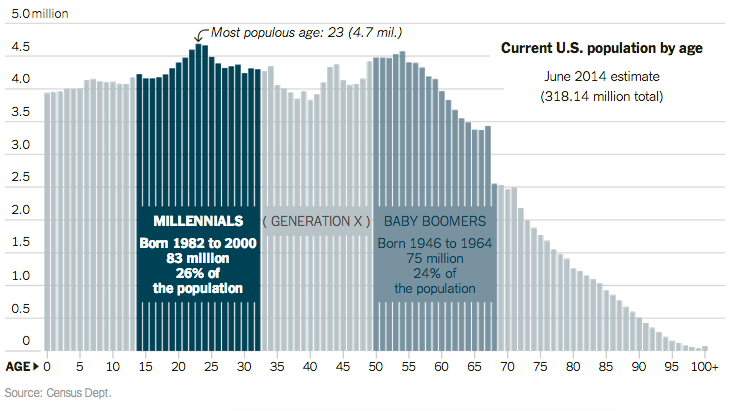
Even if today’s consumers haven’t graduated college, they do know what they’re after in a product. They want results and they won’t let their human brain function be swayed by fancy copy that doesn’t give at least a sneak peek of the results that they can expect.
To market successfully to this group of consumers, you need solid research and data.
A study conducted by Harvey Research on “How to Sell with Ad Readership Studies” found that “one of the primary reasons for conducting an ad readership study is to obtain research which will help your organization sell advertising.”
When this research is documented and the data shared with advertisers, it becomes a marketing partner.
In advertising, the result is the data — that is, the actionable metrics. If your product helped a customer increase lead generation by 27%, that’s a metric that you can use to win more clients.
Have you ever wondered how introverts successfully sell products? An introvert is a person whose motives, actions, social preferences and human brain functions are directed inwards. Introverts generally don’t enjoy the human behavior associated with convincing or negotiating.
They’re reserved. Selling is not their preferred task, yet many of them end up becoming top salespeople and industry power players.
Brian Tracy was an introvert, but by studying consumer psychology and cognitive science and learning what social signals prompt people to buy, he’s become exceptionally successful through neuroscience principles of sales.
One of the sales secrets that the introvert masters know is that it’s much better to sell the results of a product, instead of the product itself.
Selling the result can be likened to painting a clear picture of your target in an ideal future setting — a point in time where they’ve conquered their challenge or solved their problem successfully — and displaying it on a shelf.
People who know that person will be captivated by the promise of the painting.
In the same vein, when you paint the picture of your product’s results and show people how easily they can use it, you’ll build interest and inspire action in them.
According to Tara Gentle,
People aren’t looking for your service (or your product, or your program). They’re looking for results.
In other words, your product isn’t the selling point, so why make it the focus? For example, instead of writing your copy headlines using your product name, focus on the product’s results.
A few ways to sell results instead of products are:
Lead with the value of the product, not the title: If your product helps people cut 5 hours off their workweek, lead with that. It’s your competitive advantage.
If your offer (e.g., service, program, online course, etc.) helps people lose 10 pounds in 60 days, let your copy focus on that core benefit.
Derek Halpern sells the result of his online course, “Yes Engines.” See the captivating title?:
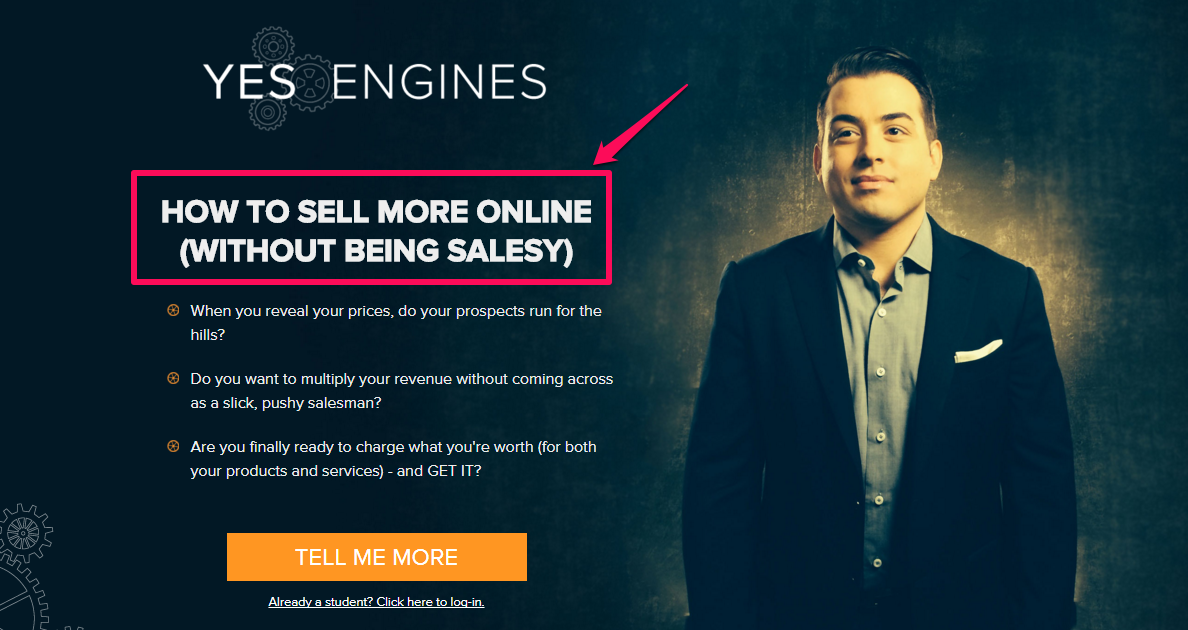
Showcase before and after results: Fitness trainers know how to use “before” and “after” pictures and videos to improve self-esteem, inspire action, and improve positive cognitive function.
If you’re looking to lose weight, would you be excited when you see amazing case study results from people like you and then find out you can do the same?
The same thing applies to makeup products or tutorials. If you’ve been searching for a makeup training program and you came across the before & after pictures below, would you want to know more?

In selling the results of a product, rather than the product itself, you’ve got to use visuals that allow your customers to see themselves getting the results they want. Don’t just describe what the end result will look like; represent it with visuals.
Even scientists are in sales. How do scientists sell brain science, cellular neuroscience or experimental psychology to the public? The public isn’t naturally interested in subjects such as developmental neurobiology, computational neuroscience, functional magnetic resonance imaging, or neural systems.
Also, difficult and upsetting subjects such as Alzheimer’s disease, brain damage, post-traumatic stress disorder, or other mental health issues can be difficult to sell to a reader.
Are there any typical results they have to show, the way a blogger who created an online course on how to “get 1000 email subscribers” would?
More than likely, the scientists don’t have visual results to show. Instead, they sell the validity of a case study and its importance to appeal to the reader’s cognitive psychology.
A study by Vanderbilt University concluded that scientists sell scientific data and ideas by convincing their peers and colleagues of the study’s validity and importance.
Since the population usually can’t fully understand all of the wide range of implications of scientific data, a scientist’s “pitch” is often translated by the news media into something that a lay audience can understand.
In many niches, before you can sell a product you need to first acquire leads, nurture them, and convince them to buy.
Selling isn’t a one-way street. Several factors play a vital role. The platforms where you generate your leads matter. Most people have generated more leads through Facebook ads than Google Ads.
On the other hand, the quality of leads of Google Ads tends to be higher.
When it comes to giving people value for their time and money, Google leads the pack. Google sells advertising, not search results.
That is why paid ads in Google are clearly marked and set apart from the actual search results. When it comes to displaying the right results, here’s what Google says:
Google search results take into account who links to a web page as well as how relevant the content on that page is to your search. Our results reflect what the online community believes is important, not what we or our partners think you ought to see.
As you can see, Google sells advertising on its search engine, but it delivers the most relevant, valuable, and helpful search results in its organic listings. Site owners can neither pay to stay at the top of the search results pages, nor manipulate their rankings (at least, not for long).
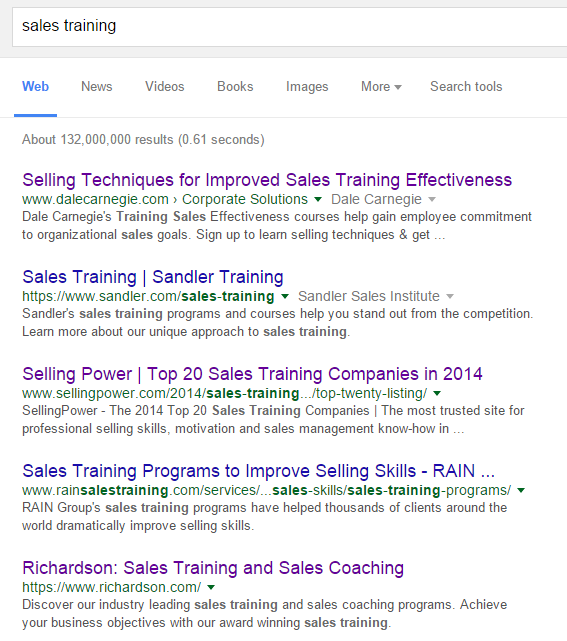
Google is the leading digital advertising company because first, it understands what people want, and second, it’s committed to providing the best search results.
5. Credibility Depends on Trust and Expertise
You are more likely to make sales when you have built credibility.
You can build credibility in a number of ways, including by providing top-notch customer service.
Customers want to reach an agent who can help them resolve problems quickly. They also want to interact with real people and gain access to information to resolve issue themselves.
Trust + expertise = credibility.
You can’t succeed in business if you lack credibility. Top brands can boast about their products, because over the years they’ve become known and are credible, offering social security.
That’s why it’s difficult for a new marketer, organization, or company to dominate the marketplace.
Customers’ cognitive functions are scared to trust you or your product. After all, you might take their money and vanish. Customer service is the hallmark of credibility. It builds credibility from the ground up.
The viral effect of bad customer service is alarming. More people share negative experiences than they share good ones. 66% of customers who experienced negative (bad) customer experience want to discourage others from buying from that company.
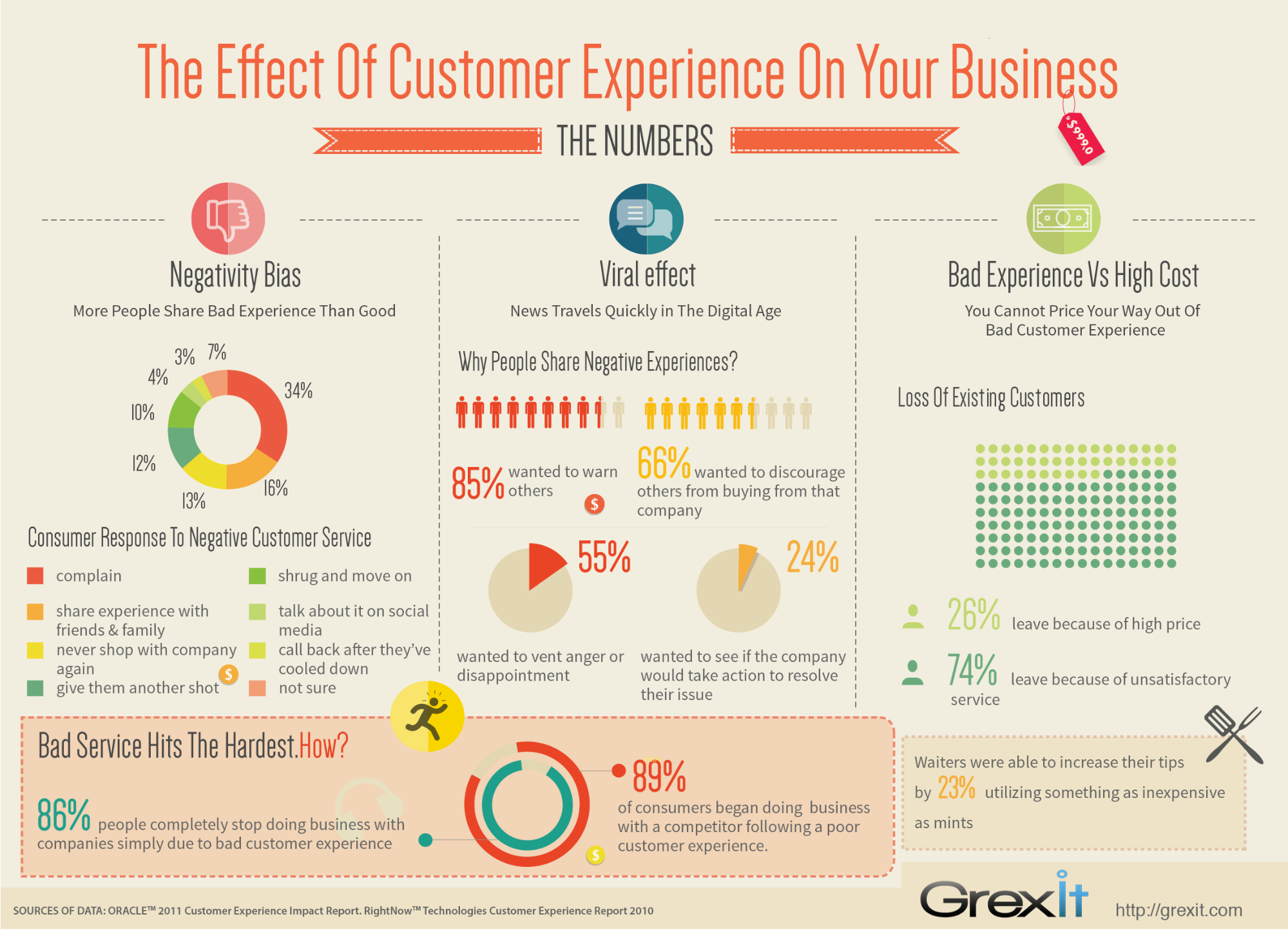
86% of people completely stopped doing business with companies over bad customer experiences. It negatively affects their human brain functions.
Every day, I wake up and ask myself a question: “What’s the best thing I can do for my customers today?”
It’s a simple, slightly dramatic exercise that reinforces for me the importance of building trust in prospect’s minds. People won’t trust you unless you’ve proven yourself and delivered immense value over a period of time.
How do you establish credibility when you’re an online business owner?
Stanford Web Credibility Research compiled 10 guidelines for building the credibility of a website. This can be applied to your product, personality, and brand.
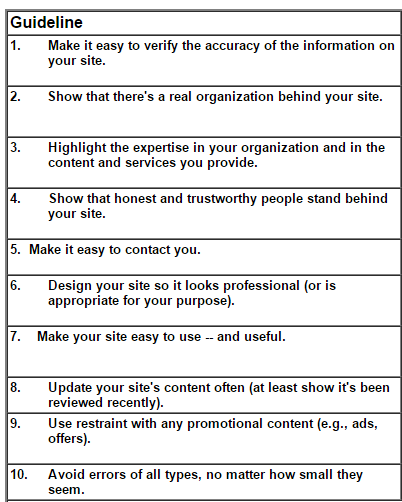
Most local businesses know how to build credibility. They use sentiment to affect human behavior. While others are struggling to earn a customer’s trust, local businesses donate to schools, sponsor children’s sports teams and participate in community events bulletin boards.
Be willing to work hard. People respect people who work hard. But, don’t make it all about yourself. Credibility is best earned by looking out for the interests of other people.
Here are a few simple ways to improve your credibility:
Answer questions correctly: Trust and transparency are just as important to corporate reputation as the quality of products and services. If you give incorrect answers it will damage your reputation.
When people ask you questions, if you don’t know the right answer, then say so. Offer to do some research and get back to them.
Whatever you do, don’t spout off with something you’re not sure of just to sound intelligent. The more you answer questions correctly, the more people will trust you.
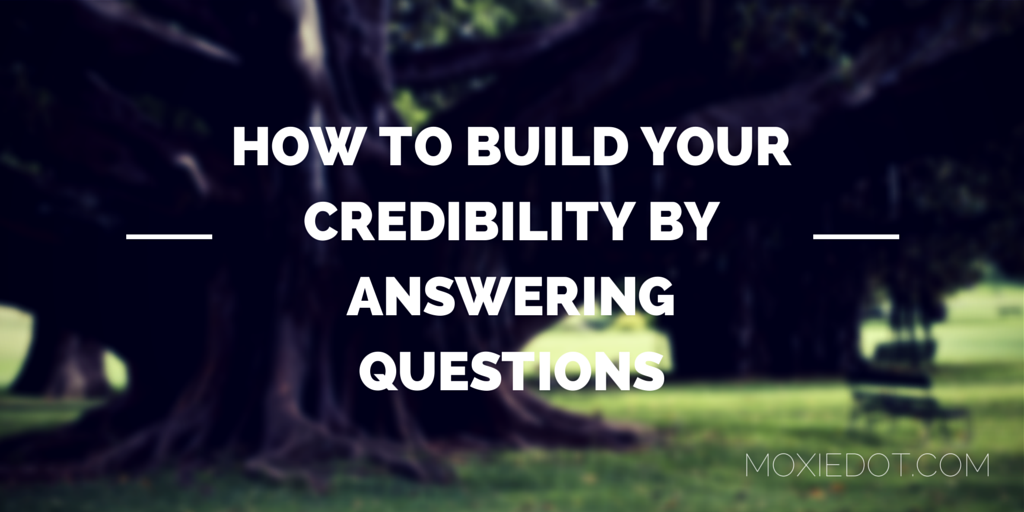
Produce valuable content regularly: There is no shortcut to content creation. You either do it yourself or outsource it to a knowledgeable freelance writer.
Always publish new content that helps people achieve their goals more easily. Your credibility level will increase.
Don’t just create generic content. Instead, focus on creating custom content that will be relevant to your audience and in sync with your goal.
Offer to solve relevant problems: If you have unique skills, you can offer to solve relevant problems for your target audience.
For example, if you’re a website developer, you could offer to help readers tweak their WordPress themes, or show them how to do it easily themselves.
Build relationships: We all need to treat others fairly, recognize their inherent worth, and respect them.
Don’t let your human behavior be solely consumed by the amount of money you can make. Instead, now and again, help people for free. Brenton Hayden recommends that you follow a few specific strategies if you want to up your credibility:
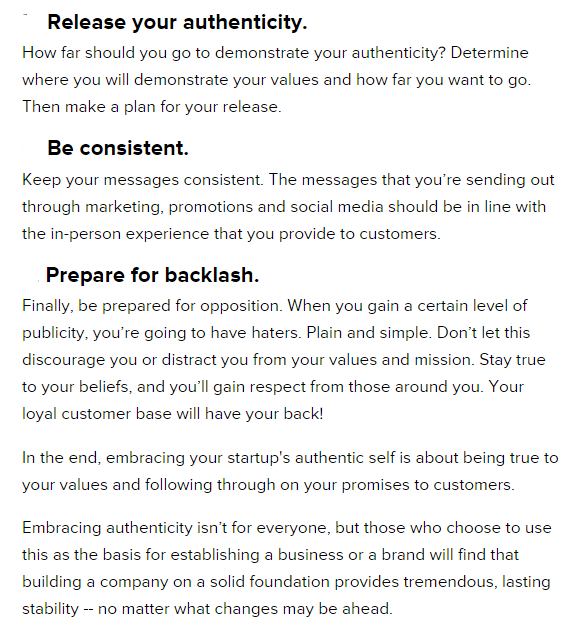
In today’s marketplace, brands and products disappear as quickly as they appear. Most of them won’t stand the test of time.
It’s obvious that the way to improve your credibility is to build relationships with prospects and customers and earn their trust.
You can also build credibility by showcasing customer success stories. If you don’t have any authority at all, it may be hard for people to trust you. The best approach to appeal to their cognitive functions is to show that your product really works.
Drew Manning, founder of Fit2Fat2Fit, knows how to showcase real-life results. He discovered that most people who sell fitness programs and products are athletic, fit people who have never been overweight.
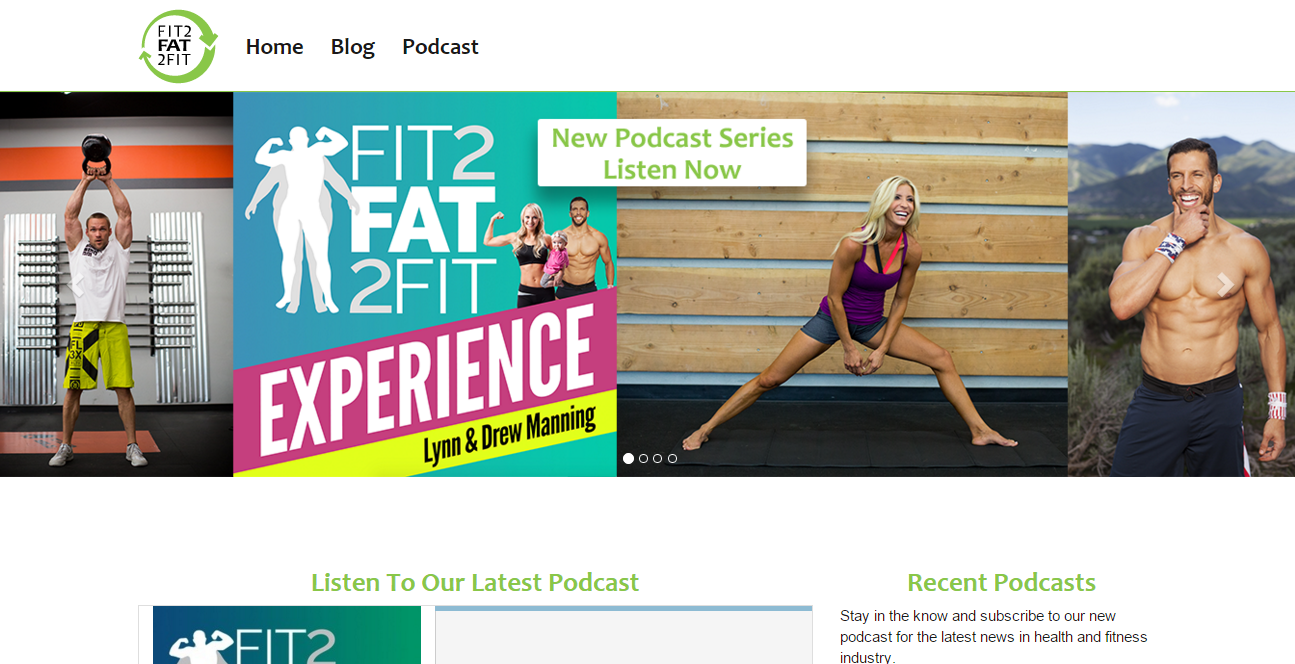
How can they possibly understand the human brain functions behind the struggles that overweight people endure and what that feels like?
Drew Manning did things differently. He spent 6 months gaining over 70 lbs. He then spent another 6 months taking the weight off.
This transformation was a source of confidence to potential customers. They thought, “If it worked for him, it’ll work for me, too.”

6. Sales Is a “Give and Give” Relationship
Giving usually comes into focus during the holiday season.

In The Science of Giving: Experimental Approaches To The Study of Charity, author Daniel M. Oppenheimer estimated that Americans donate over $300 billion each year to charity.
When you’re selling a product online or offline, giving should be in the form of value.
For example, you could give 1 – 10 GB free to customers who register your cloud storage solution, as pCloud does.
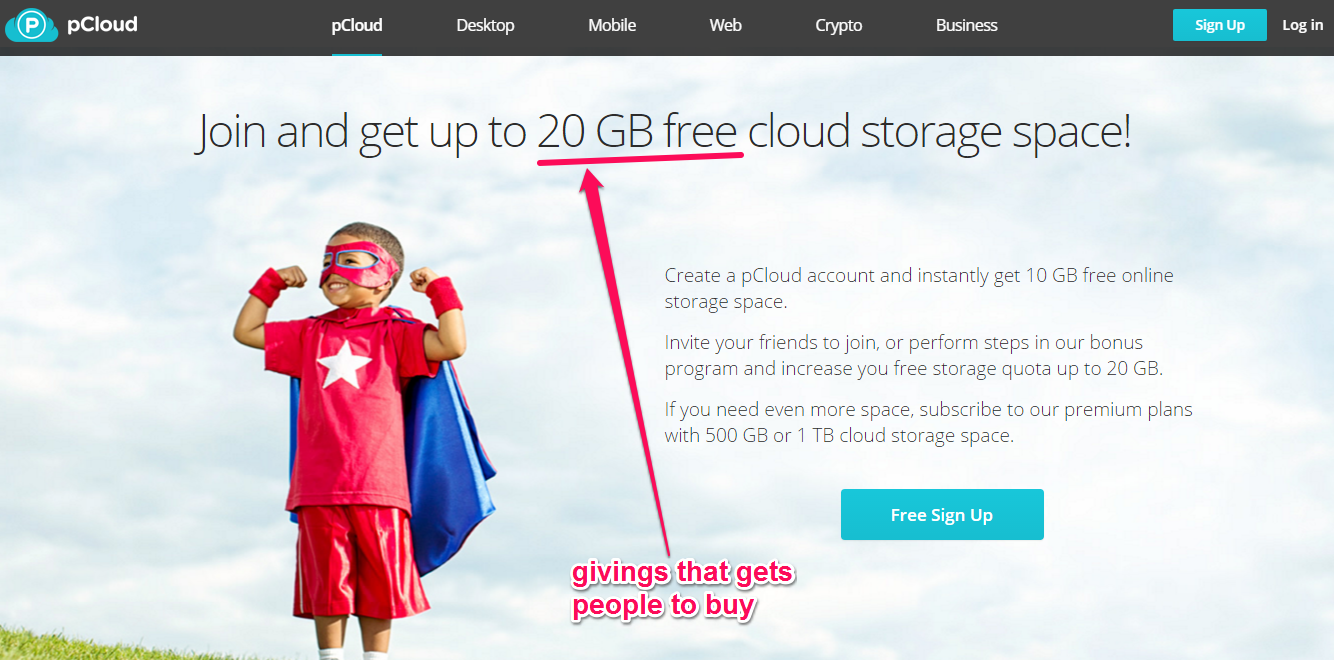
If you’re an author, you could give away the first two chapters of your book for free.
Giving is what I do on a daily basis because it’s the only way to build a sales relationship with potential customers.
I spent $30,000 on content creation; and instead of selling it, I gave the content away for free.
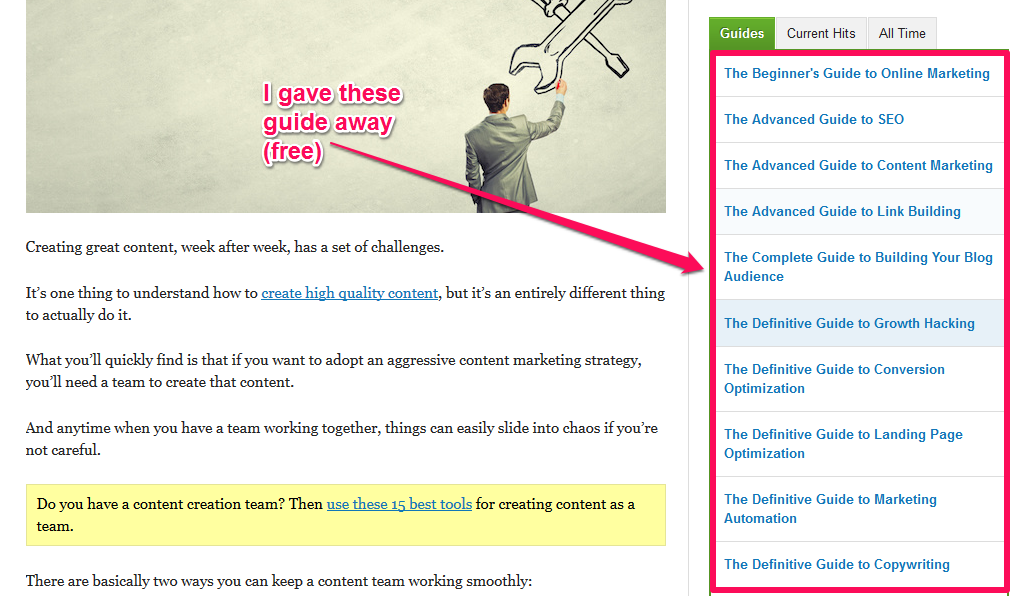
Your customers are your best salespeople. Before they can recommend your product to other prospects, you need to make up your mind to give and give. That’s the relationship between you and customers.
According to the Agricultural Marketing Resource Center, there is a way to sell that is rewarding, positive, and even enjoyable. It’s called relationship marketing and it’s a message Dale Carnegie started delivering over 80 years ago.
When you first establish a relationship with prospects, it affect their neural development and becomes easier to sell to them. The best salespeople are the best givers.
Contrary to what most people think, it’s not a “give and take” relationship, because you’re not taking anything from your audience.
If you love your customers (of course you should), then look for ways to give them as much value as possible and let it be more than what they’ll pay for.
Even though they may buy your product, that doesn’t mean you’re taking from them. The value of your product/service is expected to be higher than the price they paid for it.
Don’t get tired of giving. It’s your life as an entrepreneur, whether you run a brick-and-mortar business or are an online marketer.
Creating relationships that drive sales is critical to your business. That’s how top brands like Amazon, Zappos, Home Depot, and the like thrive in this competitive age.
The existing brain science research in psychology, economics, and neuroscience exploring the benefits of charitable giving has been largely correlational. Does it cause more happiness and fulfillment? Or is the connection between happiness and giving just a happy accident?
Happiness is a positive form of emotion, the province, and function of the limbic brain region.
To sell more products, give more value for free. According to Dunn and Norton, a study on happiness shows that the most satisfying way to use money is to invest in others. This might explain why so many people donate to charities that work in developing countries.
You can learn from two of America’s leading billionaires: Bill Gates and Warren Buffett. Buffett donated 99% of his wealth to help charitable causes, saying “I couldn’t be happier with that decision.”

Both billionaires give quite a bit to the world. Yet, here they willingly moved themselves down from being billionaires to millionaires. Heartfelt giving brings more into your life and your business.
Successful internet marketers who generated 6 or 7 figure incomes when they launched their products online followed this strategy.
They first started by giving tremendous value, well before selling. Eben Pagan, Frank Kern, Jeff Goins, Bill Baren and others launched their products in this manner.
For example, before Brian Dean opened his premium course “SEO That Works,” he first taught the best way to get top rankings for free in a blog post. I’m subscribed to his email list, so I can tell you that the value he provided made purchasing his online course a very simple decision. because he had already created tons of value for me.
If you don’t have a product to sell at the moment, it shouldn’t stop you from giving a richer experience to your prospects. Create high-quality content consistently.
I’ve been blogging for over a decade. Since that time, I’ve been creating 3 – 5 in-depth, relevant and valuable pieces of content for my audience each week.
That’s why you see huge traffic spikes in my blogs and a growing customer base for my software businesses.
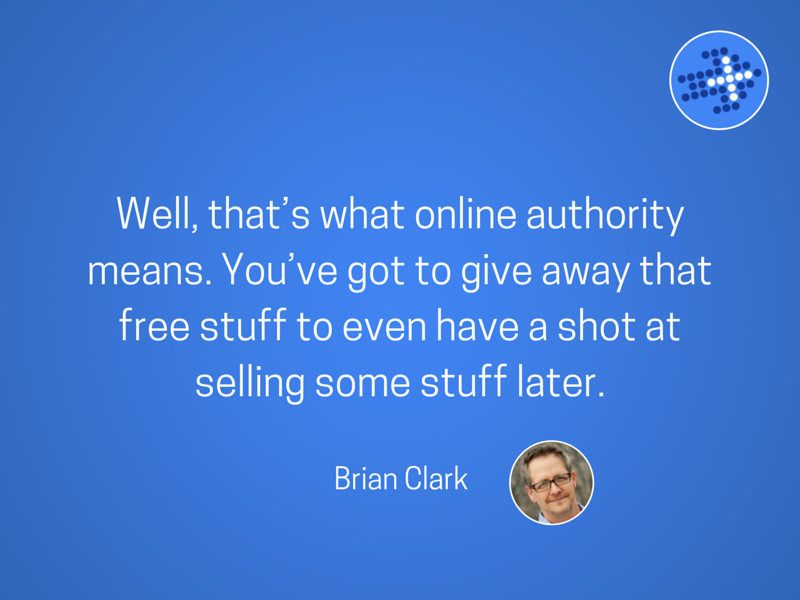
New studies prove that giving is beneficial not just for the recipients, but for the givers’ health and happiness. Giving promotes cooperation, positive human behavior, and social connection.
This is what you need to boost sales.
A study by sociologists Brent Simpson and Robb Willer showed that “when you give to others, your generosity is likely to be rewarded by others down the line—sometimes by the person you gave to, sometimes by someone else.”
7. To Close More Sales, Stop Selling
Brian Dean, the founder of Backlinko and SEO That Works, understands how to persuade people to sign up for his online course.
Even though his online course is closed, he still sells by requesting that you join the waiting list.
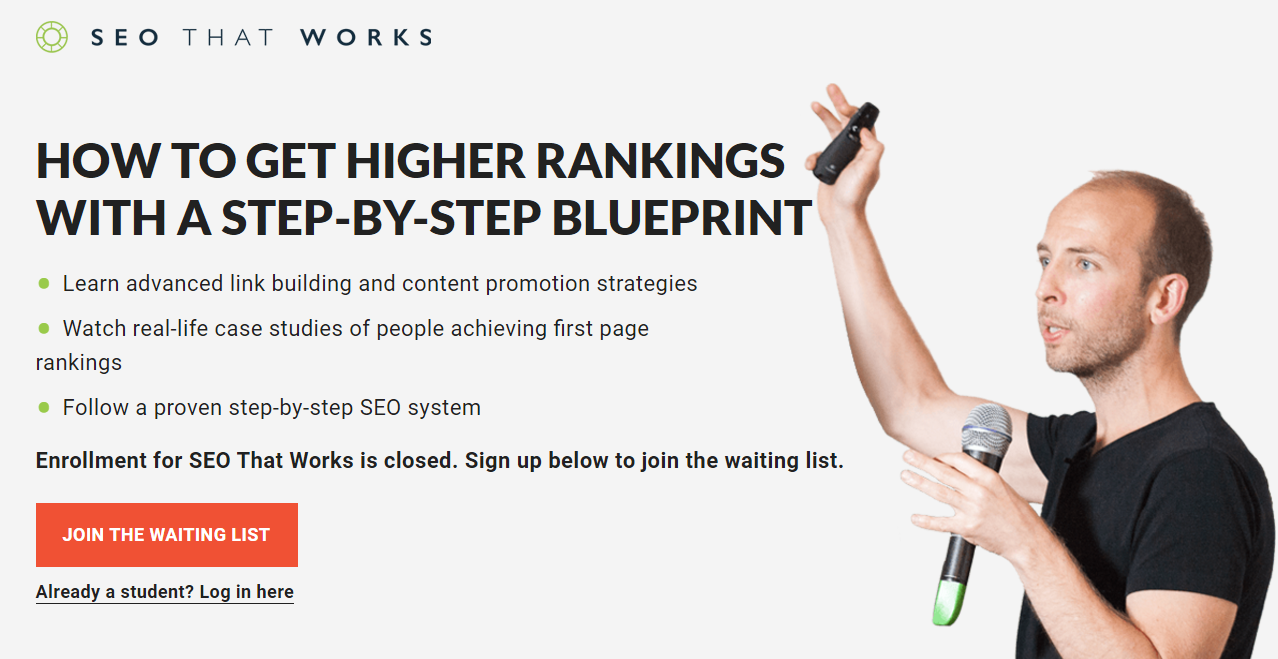
Why does he do this?
Well, when people join his waiting list, they get quality advice and case studies of people achieving first page rankings, etc. By the time the course re-opens again, subscribers who joined the waiting list will be desperate for the online course.
The majority of them will eagerly enroll. After all, they’ve already received tremendous value, free of charge.
In other words, stop pushing your products to the target audience. Instead, push high-value content. Answer questions and show the results of your services or products.
One company that sells its products quite successfully without sounding too salesy is BlendTec. BlendTec took a novel approach way back in 2007 with its “Will It Blend?” series.
The founder, Tom Dickson, understands that what people are looking for in a blender is the blade’s sharpness and the motor’s strength.
In each video in the “Will It Blend?” series, Tom tests his blender by blending anything from cell phones to wooden rakes.
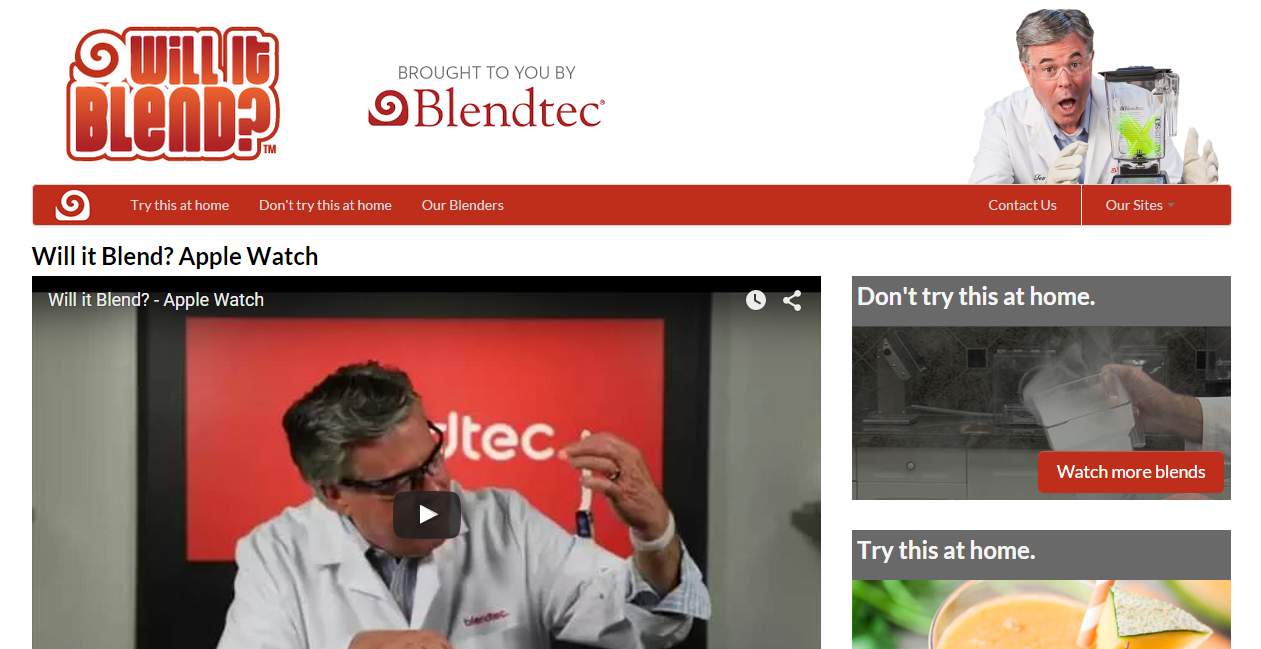
Don’t try to push sales too much. Instead, educate more. Become a teacher. Become passionate about helping other people.
Brian Clark, the founder of Copyblogger, discovered early in his content marketing business that “Teaching Sells.”
When he started teaching instead of selling, he turned his blog into a multi-million dollar software business. He also went on to start another new business called RainMaker.fm.
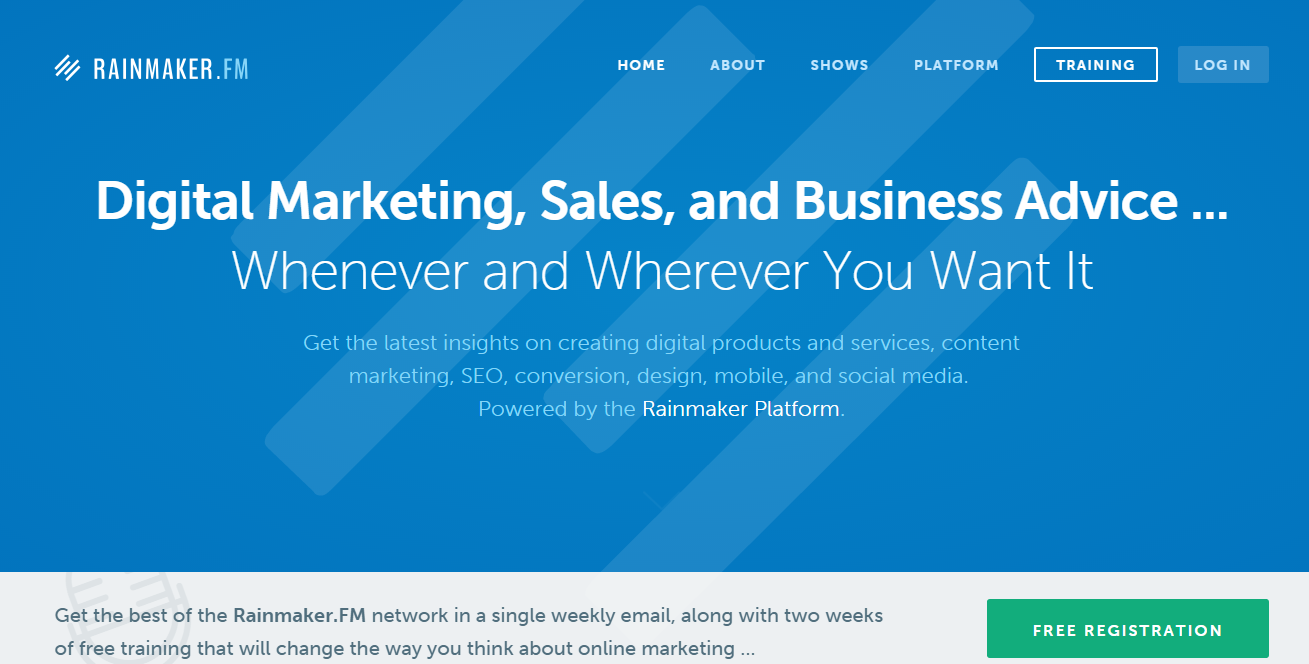
When you teach, you’re giving away value that people can’t find elsewhere. If you continually educate and inform your target audience, you’ll sell more products or services in the process.
Conclusion
If you can tap into how your customer’s brains works at different stages in the purchasing process or lead funnel, you may be able to drive more sales with less effort.
The neuroscience sales tips we’ve provided should help you get started thinking about how you can leverage the power of the human brain in your own digital marketing strategy.
If all of this sounds intimidating and you want help enacting these principles, let us know. Our team of experts are ready and waiting to partner with you to create a stellar SEO or marketing plan that drives sales by considering how your customers think.
Which of these cognitive neuroscience principles have you applied to increase your product sales online?
See How My Agency Can Drive Massive Amounts of Traffic to Your Website
- SEO – unlock massive amounts of SEO traffic. See real results.
- Content Marketing – our team creates epic content that will get shared, get links, and attract traffic.
- Paid Media – effective paid strategies with clear ROI.
MARKETING
Tinuiti Marketing Analytics Recognized by Forrester

Rapid Media Mix Modeling and Proprietary Tech Transform Brand Performance
Tinuiti, the largest independent full-funnel performance marketing agency, has been included in a recent Forrester Research report titled, “The Marketing Analytics Landscape, Q2 2024.” This report comprehensively overviews marketing analytics markets, use cases, and capabilities. B2C marketing leaders can use this research by Principal Analyst Tina Moffett to understand the intersection of marketing analytics capabilities and use cases to determine the vendor or service provider best positioned for their analytics and insights needs. Moffett describes the top marketing analytics markets as advertising agencies, marketing dashboards and business intelligence tools, marketing measurement and optimization platforms and service providers, and media analytics tools.
As an advertising agency, we believe Tinuiti is uniquely positioned to manage advertising campaigns for brands including buying, targeting, and measurement. Our proprietary measurement technology, Bliss Point by Tinuiti, allows us to measure the optimal level of investment to maximize impact and efficiency. According to the Forrester report, “only 30% of B2C marketing decision-makers say their organization uses marketing or media mix modeling (MMM),” so having a partner that knows, embraces, and utilizes MMM is important. As Tina astutely explains, data-driven agencies have amplified their marketing analytics competencies with data science expertise; and proprietary tools; and tailored their marketing analytics techniques based on industry, business, and data challenges.
Our Rapid Media Mix Modeling sets a new standard in the market with its exceptional speed, precision, and transparency. Our patented tech includes Rapid Media Mix Modeling, Always-on Incrementality, Brand Equity, Creative Insights, and Forecasting – it will get you to your Marketing Bliss Point in each channel, across your entire media mix, and your overall brand performance.
As a marketing leader you may ask yourself:
- How much of our marketing budget should we allocate to driving store traffic versus e-commerce traffic?
- How should we allocate our budget by channel to generate the most traffic and revenue possible?
- How many customers did we acquire in a specific region with our media spend?
- What is the impact of seasonality on our media mix?
- How should we adjust our budget accordingly?
- What is the optimal marketing channel mix to maximize brand awareness?
These are just a few of the questions that Bliss Point by Tinuiti can help you answer.
Learn more about our customer-obsessed, product-enabled, and fully integrated approach and how we’ve helped fuel full-funnel outcomes for the world’s most digital-forward brands like Poppi & Toms.
The Landscape report is available online to Forrester customers or for purchase here.
MARKETING
Ecommerce evolution: Blurring the lines between B2B and B2C

Understanding convergence
B2B and B2C ecommerce are two distinct models of online selling. B2B ecommerce is between businesses, such as wholesalers, distributors, and manufacturers. B2C ecommerce refers to transactions between businesses like retailers and consumer brands, directly to individual shoppers.
However, in recent years, the boundaries between these two models have started to fade. This is known as the convergence between B2B and B2C ecommerce and how they are becoming more similar and integrated.
Source: White Paper: The evolution of the B2B Consumer Buyer (ClientPoint, Jan 2024)
What’s driving this change?
Ever increasing customer expectations
Customers today expect the same level of convenience, speed, and personalization in their B2B transactions as they do in their B2C interactions. B2B buyers are increasingly influenced by their B2C experiences. They want research, compare, and purchase products online, seamlessly transitioning between devices and channels. They also prefer to research and purchase online, using multiple devices and channels.
Forrester, 68% of buyers prefer to research on their own, online . Customers today expect the same level of convenience, speed, and personalization in their B2B transactions as they do in their B2C interactions. B2B buyers are increasingly influenced by their B2C experiences. They want research, compare, and purchase products online, seamlessly transitioning between devices and channels. They also prefer to research and purchase online, using multiple devices and channels
Technology and omnichannel strategies
Technology enables B2B and B2C ecommerce platforms to offer more features and functionalities, such as mobile optimization, chatbots, AI, and augmented reality. Omnichannel strategies allow B2B and B2C ecommerce businesses to provide a seamless and consistent customer experience across different touchpoints, such as websites, social media, email, and physical stores.
However, with every great leap forward comes its own set of challenges. The convergence of B2B and B2C markets means increased competition. Businesses now not only have to compete with their traditional rivals, but also with new entrants and disruptors from different sectors. For example, Amazon Business, a B2B ecommerce platform, has become a major threat to many B2B ecommerce businesses, as it offers a wide range of products, low prices, and fast delivery
“Amazon Business has proven that B2B ecommerce can leverage popular B2C-like functionality” argues Joe Albrecht, CEO / Managing Partner, Xngage. . With features like Subscribe-and-Save (auto-replenishment), one-click buying, and curated assortments by job role or work location, they make it easy for B2B buyers to go to their website and never leave. Plus, with exceptional customer service and promotional incentives like Amazon Business Prime Days, they have created a reinforcing loyalty loop.
And yet, according to Barron’s, Amazon Business is only expected to capture 1.5% of the $5.7 Trillion addressable business market by 2025. If other B2B companies can truly become digital-first organizations, they can compete and win in this fragmented space, too.”
If other B2B companies can truly become digital-first organizations, they can also compete and win in this fragmented space
Joe AlbrechtCEO/Managing Partner, XNGAGE
Increasing complexity
Another challenge is the increased complexity and cost of managing a converging ecommerce business. Businesses have to deal with different customer segments, requirements, and expectations, which may require different strategies, processes, and systems. For instance, B2B ecommerce businesses may have to handle more complex transactions, such as bulk orders, contract negotiations, and invoicing, while B2C ecommerce businesses may have to handle more customer service, returns, and loyalty programs. Moreover, B2B and B2C ecommerce businesses must invest in technology and infrastructure to support their convergence efforts, which may increase their operational and maintenance costs.
How to win
Here are a few ways companies can get ahead of the game:
Adopt B2C-like features in B2B platforms
User-friendly design, easy navigation, product reviews, personalization, recommendations, and ratings can help B2B ecommerce businesses to attract and retain more customers, as well as to increase their conversion and retention rates.
According to McKinsey, ecommerce businesses that offer B2C-like features like personalization can increase their revenues by 15% and reduce their costs by 20%. You can do this through personalization of your website with tools like Product Recommendations that help suggest related products to increase sales.
Focus on personalization and customer experience
B2B and B2C ecommerce businesses need to understand their customers’ needs, preferences, and behaviors, and tailor their offerings and interactions accordingly. Personalization and customer experience can help B2B and B2C ecommerce businesses to increase customer satisfaction, loyalty, and advocacy, as well as to improve their brand reputation and competitive advantage. According to a Salesforce report, 88% of customers say that the experience a company provides is as important as its products or services.
Market based on customer insights
Data and analytics can help B2B and B2C ecommerce businesses to gain insights into their customers, markets, competitors, and performance, and to optimize their strategies and operations accordingly. Data and analytics can also help B2B and B2C ecommerce businesses to identify new opportunities, trends, and innovations, and to anticipate and respond to customer needs and expectations. According to McKinsey, data-driven organizations are 23 times more likely to acquire customers, six times more likely to retain customers, and 19 times more likely to be profitable.
What’s next?
The convergence of B2B and B2C ecommerce is not a temporary phenomenon, but a long-term trend that will continue to shape the future of ecommerce. According to Statista, the global B2B ecommerce market is expected to reach $20.9 trillion by 2027, surpassing the B2C ecommerce market, which is expected to reach $10.5 trillion by 2027. Moreover, the report predicts that the convergence of B2B and B2C ecommerce will create new business models, such as B2B2C, B2A (business to anyone), and C2B (consumer to business).
Therefore, B2B and B2C ecommerce businesses need to prepare for the converging ecommerce landscape and take advantage of the opportunities and challenges it presents. Here are some recommendations for B2B and B2C ecommerce businesses to navigate the converging landscape:
- Conduct a thorough analysis of your customers, competitors, and market, and identify the gaps and opportunities for convergence.
- Develop a clear vision and strategy for convergence, and align your goals, objectives, and metrics with it.
- Invest in technology and infrastructure that can support your convergence efforts, such as cloud, mobile, AI, and omnichannel platforms.
- Implement B2C-like features in your B2B platforms, and vice versa, to enhance your customer experience and satisfaction.
- Personalize your offerings and interactions with your customers, and provide them with relevant and valuable content and solutions.
- Leverage data and analytics to optimize your performance and decision making, and to innovate and differentiate your business.
- Collaborate and partner with other B2B and B2C ecommerce businesses, as well as with other stakeholders, such as suppliers, distributors, and customers, to create value and synergy.
- Monitor and evaluate your convergence efforts, and adapt and improve them as needed.
By following these recommendations, B2B and B2C ecommerce businesses can bridge the gap between their models and create a more integrated and seamless ecommerce experience for their customers and themselves.
MARKETING
Streamlining Processes for Increased Efficiency and Results

How can businesses succeed nowadays when technology rules? With competition getting tougher and customers changing their preferences often, it’s a challenge. But using marketing automation can help make things easier and get better results. And in the future, it’s going to be even more important for all kinds of businesses.
So, let’s discuss how businesses can leverage marketing automation to stay ahead and thrive.
Benefits of automation marketing automation to boost your efforts
First, let’s explore the benefits of marketing automation to supercharge your efforts:
Marketing automation simplifies repetitive tasks, saving time and effort.
With automated workflows, processes become more efficient, leading to better productivity. For instance, automation not only streamlines tasks like email campaigns but also optimizes website speed, ensuring a seamless user experience. A faster website not only enhances customer satisfaction but also positively impacts search engine rankings, driving more organic traffic and ultimately boosting conversions.
Automation allows for precise targeting, reaching the right audience with personalized messages.
With automated workflows, processes become more efficient, leading to better productivity. A great example of automated workflow is Pipedrive & WhatsApp Integration in which an automated welcome message pops up on their WhatsApp
within seconds once a potential customer expresses interest in your business.
Increases ROI
By optimizing campaigns and reducing manual labor, automation can significantly improve return on investment.
Leveraging automation enables businesses to scale their marketing efforts effectively, driving growth and success. Additionally, incorporating lead scoring into automated marketing processes can streamline the identification of high-potential prospects, further optimizing resource allocation and maximizing conversion rates.
Harnessing the power of marketing automation can revolutionize your marketing strategy, leading to increased efficiency, higher returns, and sustainable growth in today’s competitive market. So, why wait? Start automating your marketing efforts today and propel your business to new heights, moreover if you have just learned ways on how to create an online business
How marketing automation can simplify operations and increase efficiency
Understanding the Change
Marketing automation has evolved significantly over time, from basic email marketing campaigns to sophisticated platforms that can manage entire marketing strategies. This progress has been fueled by advances in technology, particularly artificial intelligence (AI) and machine learning, making automation smarter and more adaptable.
One of the main reasons for this shift is the vast amount of data available to marketers today. From understanding customer demographics to analyzing behavior, the sheer volume of data is staggering. Marketing automation platforms use this data to create highly personalized and targeted campaigns, allowing businesses to connect with their audience on a deeper level.
The Emergence of AI-Powered Automation
In the future, AI-powered automation will play an even bigger role in marketing strategies. AI algorithms can analyze huge amounts of data in real-time, helping marketers identify trends, predict consumer behavior, and optimize campaigns as they go. This agility and responsiveness are crucial in today’s fast-moving digital world, where opportunities come and go in the blink of an eye. For example, we’re witnessing the rise of AI-based tools from AI website builders, to AI logo generators and even more, showing that we’re competing with time and efficiency.
Combining AI-powered automation with WordPress management services streamlines marketing efforts, enabling quick adaptation to changing trends and efficient management of online presence.
Moreover, AI can take care of routine tasks like content creation, scheduling, and testing, giving marketers more time to focus on strategic activities. By automating these repetitive tasks, businesses can work more efficiently, leading to better outcomes. AI can create social media ads tailored to specific demographics and preferences, ensuring that the content resonates with the target audience. With the help of an AI ad maker tool, businesses can efficiently produce high-quality advertisements that drive engagement and conversions across various social media platforms.
Personalization on a Large Scale
Personalization has always been important in marketing, and automation is making it possible on a larger scale. By using AI and machine learning, marketers can create tailored experiences for each customer based on their preferences, behaviors, and past interactions with the brand.
This level of personalization not only boosts customer satisfaction but also increases engagement and loyalty. When consumers feel understood and valued, they are more likely to become loyal customers and brand advocates. As automation technology continues to evolve, we can expect personalization to become even more advanced, enabling businesses to forge deeper connections with their audience. As your company has tiny homes for sale California, personalized experiences will ensure each customer finds their perfect fit, fostering lasting connections.
Integration Across Channels
Another trend shaping the future of marketing automation is the integration of multiple channels into a cohesive strategy. Today’s consumers interact with brands across various touchpoints, from social media and email to websites and mobile apps. Marketing automation platforms that can seamlessly integrate these channels and deliver consistent messaging will have a competitive edge. When creating a comparison website it’s important to ensure that the platform effectively aggregates data from diverse sources and presents it in a user-friendly manner, empowering consumers to make informed decisions.
Omni-channel integration not only betters the customer experience but also provides marketers with a comprehensive view of the customer journey. By tracking interactions across channels, businesses can gain valuable insights into how consumers engage with their brand, allowing them to refine their marketing strategies for maximum impact. Lastly, integrating SEO services into omni-channel strategies boosts visibility and helps businesses better understand and engage with their customers across different platforms.
The Human Element
While automation offers many benefits, it’s crucial not to overlook the human aspect of marketing. Despite advances in AI and machine learning, there are still elements of marketing that require human creativity, empathy, and strategic thinking.
Successful marketing automation strikes a balance between technology and human expertise. By using automation to handle routine tasks and data analysis, marketers can focus on what they do best – storytelling, building relationships, and driving innovation.
Conclusion
The future of marketing automation looks promising, offering improved efficiency and results for businesses of all sizes.
As AI continues to advance and consumer expectations change, automation will play an increasingly vital role in keeping businesses competitive.
By embracing automation technologies, marketers can simplify processes, deliver more personalized experiences, and ultimately, achieve their business goals more effectively than ever before.
-

 SEO7 days ago
SEO7 days agoGoogle Limits News Links In California Over Proposed ‘Link Tax’ Law
-

 SEARCHENGINES6 days ago
SEARCHENGINES6 days agoGoogle Core Update Volatility, Helpful Content Update Gone, Dangerous Google Search Results & Google Ads Confusion
-

 SEO6 days ago
SEO6 days ago10 Paid Search & PPC Planning Best Practices
-

 MARKETING6 days ago
MARKETING6 days ago2 Ways to Take Back the Power in Your Business: Part 2
-

 MARKETING5 days ago
MARKETING5 days ago5 Psychological Tactics to Write Better Emails
-

 SEARCHENGINES5 days ago
SEARCHENGINES5 days agoWeekend Google Core Ranking Volatility
-

 PPC7 days ago
PPC7 days agoCritical Display Error in Brand Safety Metrics On Twitter/X Corrected
-

 MARKETING6 days ago
MARKETING6 days agoThe power of program management in martech

